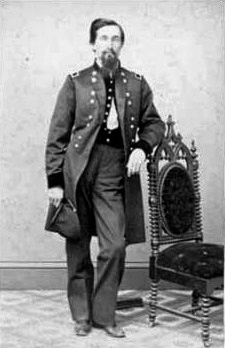John Pope Cook facts for kids
Quick facts for kids
General
John Pope Cook
|
|
|---|---|
 |
|
| Born | June 12, 1825 Belleville, Illinois |
| Died | October 13, 1910 (aged 85) Ransom, Michigan |
| Buried | |
| Allegiance | United States of America Union |
| Service/ |
United States Army Union Army |
| Years of service | 1861–1865 |
| Rank | Brigadier General Brevet Major General |
| Battles/wars | American Civil War |
John Pope Cook (born June 12, 1825 – died October 13, 1910) was an important person from Illinois. He was a politician and a general in the Union Army during the American Civil War. He fought in the western part of the war.
He played a big part in the Union's win at the Battle of Fort Donelson. His actions helped make the enemy soldiers surrender.
Before the war, he was a Congressman from Illinois. He was also the Mayor of Springfield, Illinois in 1855. In 1856, he became the Sheriff of Sangamon County. When the Civil War started in 1861, he quickly gathered soldiers. He then became a colonel in the 7th Illinois Volunteer Infantry.
He was promoted to brigadier general in 1864.
Contents
Early Life and Education
John Pope Cook was born in Belleville, Illinois. He came from a family that was well-known in politics. His grandfather, Ninian Edwards, was a U.S. Senator and the Governor of Illinois.
His father, Daniel Pope Cook, was a member of the United States House of Representatives. John's father died when he was young. His mother also passed away a few years later, leaving John an orphan.
John Cook received a good education. He later became a lawyer. In 1855, he was elected as the mayor of Springfield, Illinois. He also led a military group called the Springfield Grays. He was also in charge of supplies for the Illinois militia.
John Cook in the Civil War
When the Civil War began in April 1861, Cook's military group joined the U.S. Army. They became a key part of the 7th Illinois Volunteer Regiment. John Cook was made a colonel of this regiment.
Battle of Fort Donelson
At the Battle of Fort Donelson, Colonel Cook led the 3rd Brigade. This was a very important battle. On February 15, the Confederate soldiers tried to break out of the fort. General Ulysses S. Grant thought the Confederates had made their defenses weaker in other areas.
This weaker area was right where Cook's soldiers were. Cook's troops were supposed to make a small attack to distract the enemy. But they did much more. They managed to capture a key enemy artillery battery (a group of cannons). This helped the Union forces break through the enemy lines in that area.
After this important victory, John Cook was promoted. He became a brigadier general on March 22, 1862. He continued to lead his brigade for a short time.
Other Military Roles
Later, General Cook was put in charge of the military in Iowa and the Dakota Territory. In the winter of 1862–63, he helped plan a campaign against the Sioux Nation. His base for this was Sioux City, Iowa.
In November 1864, he was given command of the military District of Illinois. He left the volunteer army on August 24, 1865. On January 13, 1866, he was given the honorary rank of brevet major general. This meant he had the rank, but not the full pay or command of a major general.
Life After the War
After the Civil War ended, John Cook went back home. In 1869, he was elected to the Illinois General Assembly. This is where laws are made for the state of Illinois. He was a member of the Republican Party.
John Pope Cook passed away in his home near Ransom, Michigan, in 1910. He is buried at Oak Ridge Cemetery in Springfield, Illinois.

